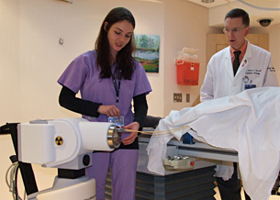Feature Story
Health Center Today, February 4, 2011
Advanced Technology for Neag Comprehensive Cancer Center Patients
By Chris DeFrancesco

Radiology technician Amy Sargent and Dr. Rob Dowsett, radiation oncologist, prepare the high-dose rate brachytherapy machine. The UConn Health Center was able to invest in this technology with a gift from Carole and Ray Neag, the university’s biggest philanthropic supporters.
Photo by Tina Encarnacion
An advanced cancer treatment is now available to UConn Health Center patients, thanks to the generosity of philanthropists and longtime university supporters Carole and Ray Neag.
High-dose rate brachytherapy temporarily delivers a high radiation source, or radioactive seed, to a tumor site. The speed and precision of this robotic therapy enables treatment on an outpatient basis and minimizes radiation exposure to healthy tissue. Brachytherapy is the delivery of a radiation source in direct proximity to a tumor.
“The Neags’ generous gift allows us to offer the latest, most advanced version of this technology to our patients,” says Dr. Rob Dowsett, radiation oncology specialist. “Compared with traditional low-dose rate radiation implants, high-dose rate brachytherapy comes with the significant advantages of being an outpatient procedure, being more versatile, and eliminating exposure for medical personnel.”
HDR brachytherapy is particularly effective in treating gynecological, breast, head and neck, pulmonary, and skin cancers, as well as sarcomas, which are tumors in connective tissue, bone, cartilage or muscle.
“Carole and I believe we should share our good fortune in a way that can help people benefit from new technology in health care,” Ray Neag says. “There of course is a cost associated with these advancements, but what they’re capable of is incredible, even unheard of not that long ago, and this is a nice thing to be able to do.”
The Neags, for whom the UConn Health Center’s cancer program is named, are the university’s most generous donors. Their $3.8 million pledge in 2008 enabled the Health Center to invest in upgrades to its diagnostic, planning and treatment services designed to enhance patient care. Those upgrades also include a new dual-source and dual-energy multi-slice computerized tomography (CT) scanner, which went online in 2009, and plans for a CT simulator that will optimize treatment planning.


